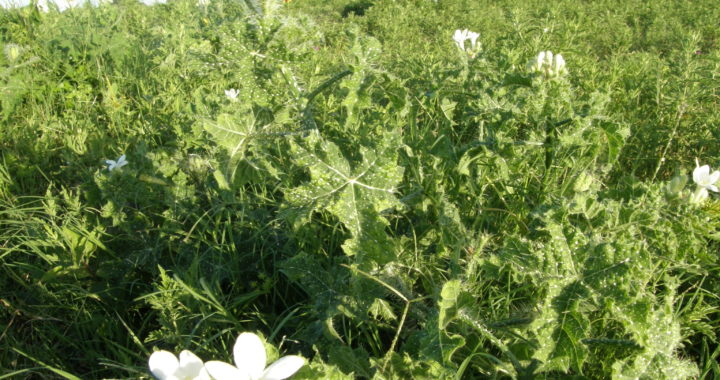Nettle (Download)
BULL NETTLE BULL NETTLE Coarse prickly weed – Fragrant white flowers Common throughout southern and eastern United States Blooms from April to August. Other names include Cnidoscolus texanus, Mala Mujer, stinging nettle, horse nettle, ball nettle, and ball nightshade. Normally an indicator of compaction and anaerobic soil, meaning there is very little oxygen available. Grows to be about 80 cm tall Has a large, finger-shaped deep branching root Leaves have 3 to 5 lobes which are toothed similar to a maple leaf Source: Jimmie W. Hinze BULL NETTLE – ANATOMY White Flowers 5 Lobe Leaves Glass-like Hairs Source: Jimmie W. Hinze IDENTIFICATION Source: Jimmie W. Hinze IDENTIFICATION Source: Jimmie W. Hinze SAFETY CONCERNS Releases a toxin into skin when touched Toxin causes an intense burning sensation Can remain red and swollen for a number of days after initial contact. Burning sensation can be intensified if allergic to Bull Nettle If allergic, contact with the plant may be fatal. REPORTED FATALITIES No fatalities were investigated by OSHA from 1990 thru 2007 that pertained to nettle. NETTLE RASH- URTICARIA Source: www.wikipedia.com OSHA 1926.604 Site Clearing (a) General requirements (1) Workers engaged in site clearing must have protection from plants , insects, and animals that may be hazardous. They must also know first aid for these hazards. SAFETY PRECAUTIONS Long Thick Pants Close-Toed Shoes Working Gloves Source: www.made-in-china.com SAFETY PRECAUTIONS The most effective precaution is avoidance of contact . To avoid contact, workers must be able to identify nettle on site. SAFETY PROCEDURES Minor rashes – Apply sting relief cream Severe rashes – Obtain Medical Treatment Source: www.firstaidmonster.com Think safety Work Safely

